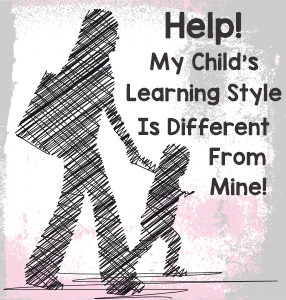How do I know that?
Well, I’m a left-brain learner. My oldest child is a right-brain learner. My youngest child is a whole-brain learner.
That’s all the children I have.
I didn’t get one single left-brain baby.
See? God has a sense of humor.
But in reality, I think that God wanted me to learn and grow, otherwise he wouldn’t have blessed me with two lovely daughters who learn differently than I do.
And I think He wants the same for you.
You too can grow by teaching a child who learns differently than you do.
That means that if you truly want that child to learn successfully, you will adjust your teaching style to fit that child’s learning style as much as possible.
I know this may be hard to swallow, but as you’ll see in a minute, it will ultimately make your job as a homeschooler much easier.
Now this doesn’t mean that if you’re left-brained and your child is right-brained, you’ll have to become a right-brained learner. YOU can continue to learn the way that works best for you. However, your approach to TEACHING is what will need to be adjusted.
You’ll simply need to create lessons, come up with activities, and present the learning material in ways that fit your child’s learning styles.
Now before you run away screaming, let me tell you why this approach works.
Learning will come more easily to your child if you teach according to his learning styles. This is especially true of challenging topics. We tend to revert to our dominant learning styles when we need to learn something difficult. For that reason, it is better to teach to your child’s strengths rather than forcing him to rely on his weaknesses.
It reduces friction and frustration. Trying to teach your child in a way that is contrary to his learning styles can create some very frustrating situations. From your perspective, you are explaining a topic in plain English and he should understand it. From his perspective, you’re speaking Greek.
It saves time. When you teach according to your child’s strengths, he will more likely grasp the concepts faster. That means less time reteaching and more time for recess.
Teaching to different learning styles is beneficial for you. Being able to use both the creative and analytical sides of your brain can help you out in many situations. And before you say “I can’t do that,” you may want to read this article by Diane Connell, Ed.D. In it she says that it IS possible to strengthen the weaker parts of our brains. I personally have found it very helpful to take a more whole-brain approach to life. I have even dabbled in using my right brain more when learning and have been very pleased with the results.
Now that you know why teaching to your child’s learning styles is beneficial, let’s look at how you can go about doing that.
First, you’ll want to read up on learning styles. Find out what helps each type of learner learn. You may find these articles on learning styles helpful:
- Visual, Auditory, and Kinesthetic Learning Styles
- How to Help Visual Learners
- How to Help Auditory Learners
- How to Help Kinesthetic Learners
- Left-Brain, Right-Brain, Whole-Brain Learning
- Left-Brain Learners
- Right-Brain Learners
You’ll notice that they include not only right-brain and left-brain learners, but also the visual, auditory, and kinesthetic learning styles. The latter styles refer to how we take in information through our senses. Being knowledgeable in all of these styles can make it easier to teach your child.
After you understand which learning styles fit your child, you can choose curriculum, develop lessons, and select activities that will facilitate learning for your child.
If you are not sure what will work well for your child, let him choose from a list of possible assignments, projects, and activities. He’ll more than likely select something that will work for him. That’s because children tend to migrate towards activities that make learning easier for themselves. It may take a little trial and error for him to figure out what types of activities are best, but that’s okay. He’s learning to learn in a way his mind sees fit.
Now to sum it up, let me share a simple rule with you:
By making learning easier for your child, you make teaching easier for yourself.
I hope this helps you out.
P.S. By the way, you can also make teaching easier for yourself by using some of the educational products and resources I have on my publishing company website. They include games, puzzles, learning packs and more. Visit www.WarmHeartsPublishing.com to see what’s available.








